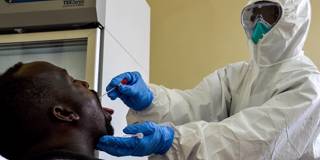Despite Uganda's large population of displaced people from neighboring wars, no confirmed cases of COVID-19 have occurred within refugee settlements. This attests to the country’s humane, sustainable, and forward-looking refugee policy, which gives displaced people the resources and support they need to make a home and a living.
KAMPALA – Perhaps the most effective health interventions in the battle against COVID-19 so far have been behavioral: social distancing and improved hygiene, especially hand-washing. For the world’s 70 million displaced people – especially the millions living in cramped camps and informal settlements – such habits can be virtually impossible. Add to that limited access to health-care services, a lack of reliable information about the virus, and governments’ focus on protecting their own citizens, and the risks of devastating COVID-19 outbreaks among displaced populations are rising fast.
Refugees International recently sounded the alarm about these risks, and offered sensible recommendations to help mitigate them, such as reducing overcrowding and improving hygiene in refugee camps, halting the deportation of asylum-seekers, and improving communication. To achieve these objectives, governments would do well to draw lessons from Uganda, a global leader in refugee protection.
Uganda, a landlocked country of 43 million people, has taken in 1.36 million refugees, making it the world’s third-largest host country. Most fled from conflicts in neighboring countries, especially in South Sudan and the Democratic Republic of the Congo. Asylum-seekers from both countries – totaling 985,512 from the former, and 271,967 from the latter so far – are granted refugee status in Uganda on a prima facie basis.

KAMPALA – Perhaps the most effective health interventions in the battle against COVID-19 so far have been behavioral: social distancing and improved hygiene, especially hand-washing. For the world’s 70 million displaced people – especially the millions living in cramped camps and informal settlements – such habits can be virtually impossible. Add to that limited access to health-care services, a lack of reliable information about the virus, and governments’ focus on protecting their own citizens, and the risks of devastating COVID-19 outbreaks among displaced populations are rising fast.
Refugees International recently sounded the alarm about these risks, and offered sensible recommendations to help mitigate them, such as reducing overcrowding and improving hygiene in refugee camps, halting the deportation of asylum-seekers, and improving communication. To achieve these objectives, governments would do well to draw lessons from Uganda, a global leader in refugee protection.
Uganda, a landlocked country of 43 million people, has taken in 1.36 million refugees, making it the world’s third-largest host country. Most fled from conflicts in neighboring countries, especially in South Sudan and the Democratic Republic of the Congo. Asylum-seekers from both countries – totaling 985,512 from the former, and 271,967 from the latter so far – are granted refugee status in Uganda on a prima facie basis.